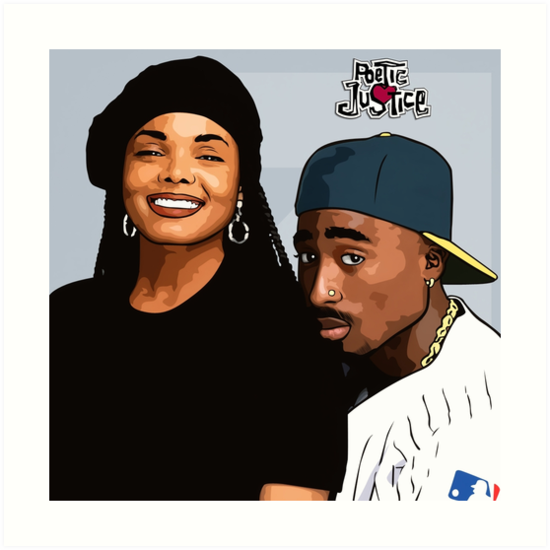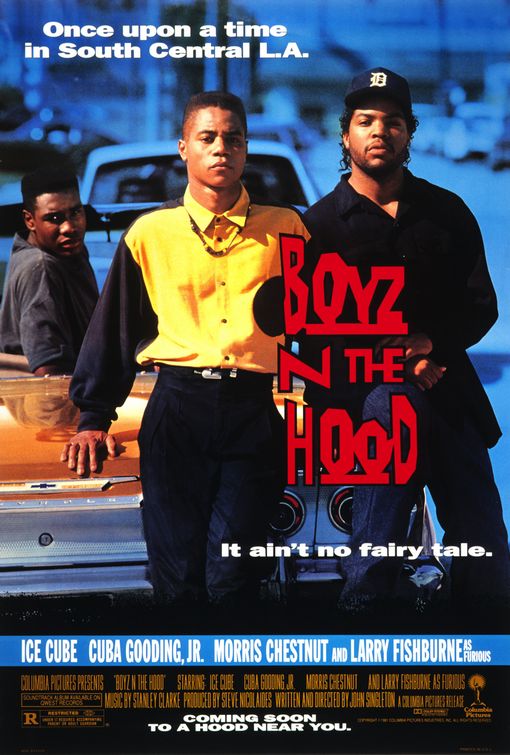Not long after graduating from the University of Southern California, John Singleton put his film school degree to work and effectively translated the subject matter of controversial rap group N.W.A.'s music to the big screen. Written with roles for the members, Singleton's debut feature film went into production after the group's break-up. As a consequence, the movie, Boyz N the Hood, only featured the first member of N.W.A. to go solo: O'Shea "Ice Cube" Jackson. Appropriately enough, Boyz takes a hard look at South Central Los Angeles - the section of the U.S.'s second-largest city, in which both Jackson and Singleton were raised. The film's phenomenal success led to the novice filmmaker making history as the youngest person -- and first African-American -- to be nominated for a Best Director Oscar, the creation of an entire subgenre and a 28-year career in Hollywood that showed no signs of slowing down when he suffered a stroke at the age of 51 this past Spring. John Singleton left an indelible mark on the film industry with his very first offering and continued to make significant contributions in his field for nearly three more decades. Here's a look at his cinematic body of work.
9. Four Brothers

In his third and final project with Tyrese Gibson, Singleton updates the 1965 western The Sons of Katie Elder, transplanting the action from rural Clearwater, Texas to inner-city Detroit and from 1898 to 2005. The quartet of siblings (Angel, Bobby, Jeremiah and Jack) return home to Michigan after the murder of their adopted mother during a convenience store robbery only to discover that there's a lot more to the shooting than meets the eye. The oldest, Bobby, has grown up to be a professional hockey washout; Jerry is a husband, father and entrepreneur; Angel is now a marine; and Jack, a local rock star. But the four former juvenile delinquents soon find themselves at the center of a deadly storm of organized crime, police corruption and gunplay.
Likely inspired by Singleton's work on the Shaft reboot five years earlier, the score features loads of 1970s era music you'd expect to hear in a Blaxploitation film.
While integrated-casting is more common now than ever in Hollywood, Singleton was way ahead of the curve. Four Brothers retains the basic story of Katie Elder, which, ironically, stars John Wayne, whose prejudices have become common knowledge since his heyday. But the remake eschews the original's all-white cast in favor of a family comprised of two caucasian and two African-American brothers, one of whom has a Hispanic girlfriend.
Nevertheless, the updated Four Brothers has its fair share of issues with racially-insensitive language, mostly uttered by the character portrayed by Mark Wahlberg (he even calls someone a "house nigger"), who served time for a racially-motivated hate crime prior to his Hollywood career. The more things change, the more things stay the same.
8. Baby Boy

Originally intended to feature Tupac Shakur as the headliner, the rapper's murder necessitated a change, with Baby Boy eventually providing Watts-native Tyrese Gibson with his first starring role and propelling him to the A-list.

Poetic Justice is Singleton's lone collaboration with both legendary rapper/actor Tupac Shakur and pop superstar Janet Jackson.
6. 2 Fast 2 Furious

Twelve years after Boyz N the Hood, John Singleton traded Doughboy's '63 Impala and Trey's '72 Cabriolet for Roman's '03 Mitsubishi Eclipse Spyder and Brian's '99 Skyline GT-R.
Appropriately enough, Singleton's contribution to the Fast and Furious series infused some Blackness into the wildly popular franchise. And new additions Roman (Tyrese Gibson) and Tej (Chris "Ludacris" Bridges) have since become mainstays in the car-chase saga.
After allowing wanted criminal Dominic Torreto escape arrest, LAPD Officer Brian O'Conner is wanted for arrest himself. So he high-tails it outta Los Angeles and eventually makes his way to Miami, financing his cross-country road trip by entering illegal street races along the way. Upon arriving in Magic City,
Brian meets up with his childhood friend Roman Pearce, who's currently under house arrest after serving time in prison for possession of stolen cars -- for which he holds Brian responsible.
The now-fugitive Brian also reconnects with his old friend, Tej Parker, a mechanic who arranges underground street-racing events.
Following one such race, Brian is arrested and offered a chance to both avoid prison and resurrect his law enforcement career. The same FBI agent who oversaw Brian's undercover operation in LA proposes that he participate in a joint investigation with U.S. Customs. The target is drug kingpin Carter Verone, with whom undercover agent Monica Fuentes has ingratiated herself. Brian agrees to the deal, with the caveat that he be allowed to recruit someone whom he trusts. When the feds reluctantly agree,
Following an introduction by Agent Fuentes, Verone hires O'Conner and Pearce to transport drugs for him, contingent upon the duo proving their skills by retrieving a package from a car in an impound lot before another team of drivers. The pair win the competition, in spite of interference from Fuentes' Customs supervisor.
While Brian is able to gather intel on Verone's plans to flee the country, he frustrates Roman by developing feelings for Fuentes, compromising his focus.
When a corrupt Miami police detective attempts to have O'Conner and Pearce arrested, Tej arranges a diversion comprised of several import tuners, allowing the pair to evade the police and save Fuentes, who Verone had determined was a federal agent. After making their way onto the drug baron's yacht, where he's holding Fuentes, Brian and Roman rescue Monica and incapacitate Verone (Brian even shoots him).
5. Abduction
Nathan Harper's a typical, suburban Pittsburgh teen: he goes to house parties; he's on the wrestling team; he rides a motorcycle; and he's nervous around his dream-girl. He also sees a therapist for his anger issues.
When a classmate notices a kid on a website for missing children who resembles him, his life changes forever. And he questions everything that he thought he knew about his family.
Unbeknownst to Nathan, his query to the site administrators draws men in black to his home -- who murder his parents and threaten his crush, who lives across the street, before blowing up the house. Nathan soon learns that he's part of a far-reaching conspiracy involving the CIA, higg-ranking U.S. traitors and Serbian spies. Fortunately for Nathan, the covert CIA agent who raised him taught him combat skills under the guise of parental discipline. And his therapist, who also works for the CIA, provides him with cash, a car, passports and a handgun. But, of course, hes still in way over his head.
4. Higher Learning

Higher Learning marked Singleton's second and final collaboration with Ice Cube.
To this day, Higher Learning is one of the few films to explore the tensions created -- and intentionally fueled -- by the various politically-minded groups on college campuses. With African-Americans fighting discrimination, women protesting sexual assault and even white supremacists whining about "making America great again", the movie also serves as a microcosm of the country nearly a quarter-century after its premiere. Perhaps most tragically, Higher Learning examines the now-commonplace phenomenon of school shootings.
3. Rosewood
While Rosewood explores the racially motivated massacre resulting in the destruction of one specific community, the events of the film serve as an example of an occurrence that happened far too often in the late 19th and early 20th centuries. Similar incidents took place in Perry, Florida, two weeks prior to the Rosewood massacre; the predominantly African-American community of Greenwood in Tulsa, Oklahoma in 1921; and Ocoee, Florida in 1920.
Though the film doesn't cover it, an all-white grand jury found insufficient evidence to indict anyone the month following the massacre -- in spite of testimony from 25 witnesses, eight of whom were African-American.
Though the Rosewood massacre received widespread media coverage immediately following the bloodbath, most of the witnesses, both African-American and white, maintained strict secrecy about the Rosewood massacre for decades afterward. The last known survivor, Mary Hall Daniels, died on May 2, 2018 at the age of 98.
And though the movie stayed remarkably close to the facts, the filmmakers did exercise dramatic license for some aspects of the story. The "Man" character is based on Ted Cole, a soldier reported by influential Black newspaper the Chicago Defender to have battled the lynch mob before disappearing. It's worth noting that several survivors changed their names after fleeing the area. "Man" was actually the nickname of Sylvester Carrier, who was found dead in his home following a shootout with the white mob, two of whom, Henry Andrews and C.P. "Poly" Wilkerson, he'd killed during the firefight.
2. Shaft

Better than anyone could've reasonably expected for a 21st century Shaft sequel, the movie follows the exploits of the famed private investigator's nephew as he attempts to bring a racist trust-fund kid to justice for the murder of a young African-American man who offended him by dating a white woman.
1. Boyz N the Hood
28 years ago, the world was a very different place. Hip-Hop was alive and well, OJ Simpson was thought of as a hero, guys didn't wear tight pants, Ice Cube was scary to white America and ghetto violence was Southern California’s best-kept secret. However, in the summer of 1991, then-23 year old first time director John Singleton brought urban violence and California hood culture to the mainstream. The recent USC film school grad gave big screen visuals to the gritty tales heard on “gangsta rap” cd's and tapes (remember it was ’91) and brought the west coast inner-city to suburban moviegoers all across the country.
That’s not to say that Singleton was the first to expose the problems in the hood. After all, the film is heavily influenced by NWA (who director Singleton had envisioned appearing in the film). Hell, the title itself, including its phonetic spelling, is an allusion to an Eazy-E song. Boyz N The Hood is not even the first film to explore the other side of Cali on-screen. However, two and a half decades ago this summer and less than a year before the L.A. riots, Boyz N The Hood was the first and one of the best in what is dismissively referred to as the “hood movie” film genre.
Boyz N The Hood has left an enormous impact on the landscape of pop culture. The film spawned an entire movie genre, which in turn led to a resurgence in African-American cinema itself. While the rise of west coast hip-hop in the early 1990's is due to NWA and their contemporaries, it's near complete saturation of radio stations and video channels is at least indirectly a result of Boyz's crossover success. Incidentally, the movie features Ice Cube in his first and arguably his best cinematic performance. Fourteen years after the movie's release Young Jeezy's first group (Boyz N Da Hood of course) even took its name from the movie.
Boyz N The Hood is still a good recommendation for anyone who hasn't seen it. Boyz received not one but two Oscar nominations for Best Director and Best Screenplay at the time of it's release. Eleven years later, in 2002, the movie was selected for membership in the National Film Registry by the Library of Congress for it's cultural significance.
Ice Cube and John Singleton at the Cannes Film Festival

John Singleton and Tupac Shakur on the set of
Poetic Justice




No comments:
Post a Comment